Complications of Benchekroun vesicostomy in a spina bifida patient: severe stenosis requiring permanent suprapubic cystostomy, recurrent vesical calculi and abdominal hernia containing ileocystoplasty - a case report
- PMID: 20062545
- PMCID: PMC2804014
- DOI: 10.1186/1757-1626-2-9371
Complications of Benchekroun vesicostomy in a spina bifida patient: severe stenosis requiring permanent suprapubic cystostomy, recurrent vesical calculi and abdominal hernia containing ileocystoplasty - a case report
Abstract
Introduction: In female patients with neuropathic bladder, the urethra is closed permanently in order to avoid urine leak. Then Benchekroun hydraulic ileal valve is attached to urinary bladder, thus providing a continent stoma for performing intermittent catheterisations.
Case presentation: We present a female patient with spina bifida who underwent Benchekroun continent vesicostomy in 1993. This patient developed severe stenosis of Benchekroun stoma and stones in urinary bladder. Dilatation of stoma and vesicolithotomy were carried out in 1995. Vesical calculi recurred; suprapubic cystolithotomy was performed in 1999. In March 2000, catheterisation of stoma was not possible and emergency suprapubic cystostomy was done. In April 2000, endoscopy was attempted through Benchekroun stoma. It was not possible to insert ureterorenoscope beyond two inches. The track was completely blocked. In November 2001, X-ray of abdomen showed several vesical calculi; suprapubic cystolithotomy was performed. In March 2005, this patient developed pain in abdomen. X-ray of abdomen showed a large vesical calculus. In June 2005, suprapubic catheter was removed and a cystoscope was introduced in to the bladder. Then electrohydraulic lithotripsy was performed. In 2007, this patient was concerned about the increasing swelling in lower abdomen. Computed tomography of abdomen revealed midline, lower abdominal wall hernia, which contained several loops of small bowel and ileal cystoplasty. The large hernia was uncomfortable and tender on coughing, but did not cause obstructive bowel symptoms. Surgical repair of hernia was considered. But this patient would require alternative way of urinary diversion because the current location of suprapubic catheter would almost lead to infection of prosthetic material used in reconstruction of the anterior abdominal wall. After discussing risks of operative procedures with patient and her husband, it was decided not to proceed with surgery.
Conclusion: This case is a poignant reminder to spinal cord physicians that novel surgical techniques should be viewed cautiously, and patients should be informed of potential complications of surgical procedures some of which could be irreversible.
Figures
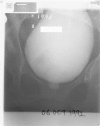
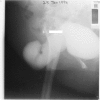
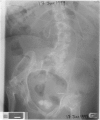

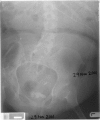

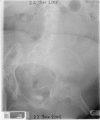
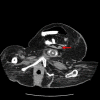
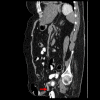
Similar articles
-
Inadvertent positioning of suprapubic catheter in urethra: a serious complication during change of suprapubic cystostomy in a spina bifida patient - a case report.Cases J. 2009 Dec 22;2:9372. doi: 10.1186/1757-1626-2-9372. Cases J. 2009. PMID: 20062546 Free PMC article.
-
Use of open-ended Foley catheter to treat profuse urine leakage around suprapubic catheter in a female patient with spina bifida who had undergone closure of urethra and suprapubic cystostomy: a case report.Cases J. 2009 Jun 12;2:6851. doi: 10.4076/1757-1626-2-6851. Cases J. 2009. PMID: 19829871 Free PMC article.
-
Hourglass urinary bladder in a spinal cord injury patient - unusual late complication of suprapubic cystostomy: a case report.Cases J. 2009 May 18;2:6866. doi: 10.1186/1757-1626-2-6866. Cases J. 2009. PMID: 19829874 Free PMC article.
-
Options for independent bladder management in patients with spinal cord injury and hand function prohibiting intermittent catheterization.Neurourol Urodyn. 2015 Feb;34(2):167-76. doi: 10.1002/nau.22516. Epub 2013 Oct 22. Neurourol Urodyn. 2015. PMID: 24151101 Review.
-
Contemporary role of suprapubic cystostomy in treatment of neuropathic bladder dysfunction in spinal cord injured patients.Neurourol Urodyn. 2008;27(6):475-9. doi: 10.1002/nau.20569. Neurourol Urodyn. 2008. PMID: 18551568 Review.
References
-
- Benchekroun A. Hydraulic valve for continence and antireflux. A 17-year experience of 210 cases. Scand J Urol Nephrol Suppl. 1992;142:66–70. - PubMed
-
- Mouriquand PD, Boddy S. Salvage procedures for failed Benchekroun hydraulic valves: experience in four patients. Br J Urol. 1996;77(5):740–744. - PubMed
LinkOut - more resources
Full Text Sources
Miscellaneous

